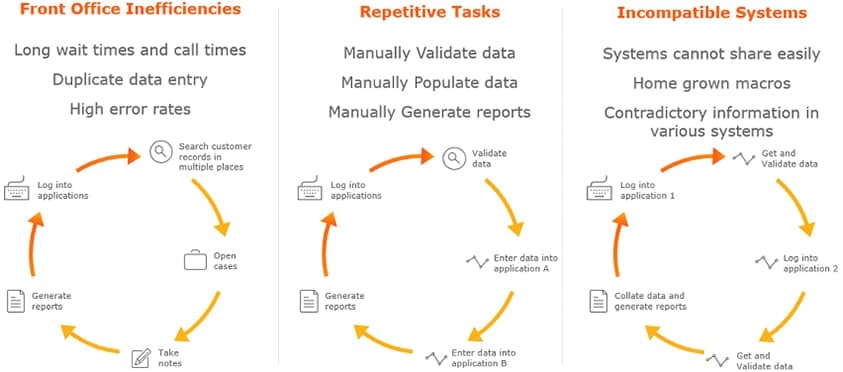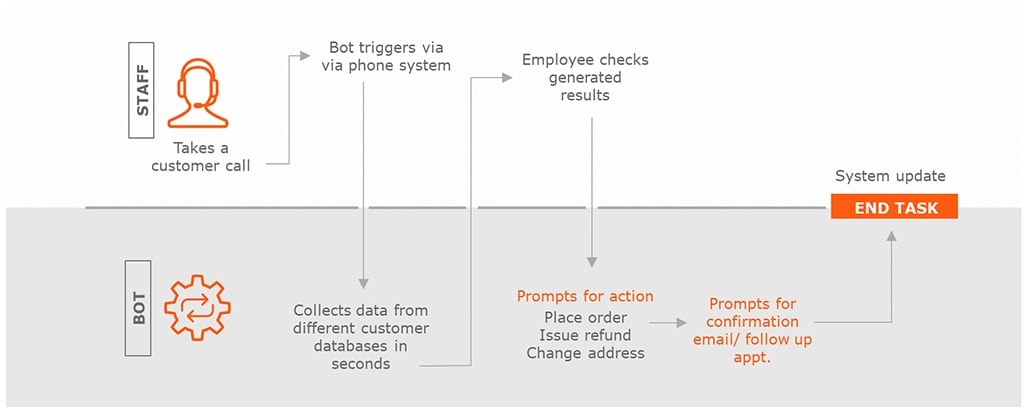- Login
- Search
- Contact Us
-
Have a question? Our team is here to help guide you on your automation journey.
-
Explore support plans designed to match your business requirements.
-
How can we help you?
-
- AI
AI Without the Hype From pilot to full deployment, our experts partner with you to ensure real, repeatable results. Get Started
- Automation Anywhere AI
-
- Solutions
Featured Agentic Solutions
Accounts Payable Invoice automation—No setup. No code. Just results. Accounts Payable
Customer Onboarding Scale KYC/AML workflows. Customer Onboarding
Customer Support Keep queues moving, even at peak load. Customer Support
Healthcare RCM Revenue cycle management that runs itself. Healthcare RCM
- Products
Platform Features
- Agentic process automation (APA)
- Robotic Process Automation (RPA)
- View all Products
-
- Resources
Get Community Edition: Start automating instantly with FREE access to full-featured automation with Cloud Community Edition.
Featured
 Named a 2025 Gartner® Magic Quadrant™ Leader for RPA.Recognized as a Leader for the Seventh Year in a Row Download report Download report
Named a 2025 Gartner® Magic Quadrant™ Leader for RPA.Recognized as a Leader for the Seventh Year in a Row Download report Download report- Become an Expert
- Developer Tools
- Get Support
- View all resources
-
- Partners
Find an Automation Anywhere Partner Explore our global network of trusted partners to support your Automation journey Find a Partner Find a Partner
- Find a Partner
- For Partners
-
Blog
Attended Automation — What Is It and Why Do I Need It?
As we are embarking on the Fourth Industrial Revolution, we find the lines between the human worker and Digital Worker blurring further and further. With the advent of artificial intelligence (AI)-based technologies such as Alexa in our homes, Tesla autopilot in our cars, and Robotic Process Automation (RPA) in our work life, digital helpers are here to stay — and for good reason, as they help humans achieve a better quality of life and work.
The problems that RPA solves include front-office and call center inefficiencies, where humans simply cannot keep up with demand and tend to make mistakes — we are human, after all. Repetitive tasks are slow and mundane to office workers, who must deal with multiple systems that don’t always like to share. Illustrated in the graphic below, we see how inefficiencies in ordinary office processes add up to create massive time and cost wasters at scale.

How attended automation works
Attended automation is deployed on the worker's desktop and increases worker productivity, while unattended automation is deployed remotely and has better scalability. In a call center, for example, the customer service agent is the “central processing unit,” as shown on the left in the diagram below. All processes must go through this person, who can become a bottleneck. (Some euphemistically call this a “swivel chair interface.”)
Automating many of those processes, as shown on the right below, will free the agent to do more high-value support service. As a result, he or she will be a much more effective employee, from both a customer satisfaction standpoint and a bottom-line perspective.

While automation can massively improve a company’s processes, it cannot do everything. There are times when bots need human help to make decisions. For example, when a chatbot is dealing with an unhappy customer or, in a borderline mortgage application case, human intervention is warranted, and attended bots can do this. Attended bots automate processes, but from time to time they need human attention to provide a decision for the highest possible efficacy.
Use cases
Let’s look at how we at Automation Anywhere define and perceive attended automation and some of the use cases we try to solve. Automation Anywhere looks at attended automation as a set of design and runtime features that facilitate humans and Digital Workers to support each other for faster, better results and, ultimately, a higher rate of customer retention and satisfaction.
The diagram below outlines the three key types of automation that Automation Anywhere offers for enterprises to improve their processes. Stitched together, they form the hybrid RPA workplace model.

Let’s talk about the use cases where attended automation can be helpful, from the simple ones to progressively more complicated ones. These use cases include exception handling, document verification, on-demand data processing, and virtual assistants.
Exception handling for better bot resiliency
Exception handling can be described as a simplistic form of attended automation. When a bot hits an issue with a resource being unavailable or inaccessible, the user is notified and prompted for an alternate execution path.
For example, a bot is deployed to processes daily orders and creates a final report. If the database is down or inaccessible for some reason, the user can be immediately notified. This will allow the user to report and resolve the problem immediately, so his or her report creation is not delayed.

Document verification before final approval
In industries such as insurance, thousands of claims must be processed quickly and accurately to ensure internal compliance, keep costs in line, and maintain customer satisfaction at the highest possible levels. RPA is the perfect solution for processing these claims, as most of them are very similar. However, sometimes additional input/approval is needed by an employee in order to complete a process. These instances might include a disputed claim, an upset customer, or even possible fraud. Attended bots can be programmed to identify these instances and defer them to a human, with the goal of ensuring the proper processing.
Here are some other examples:
- Document verification during mortgage loan processing
- Conditional processing of orders that are above a certain auto approval criterion
- Insurance claims that require human intervention for processing exceptions
The diagram below outlines how the exception process works, as invoked by an insurance processing agent.

On-demand data processing for increased efficiency
Today’s organizations typically have many different data sources — for example, Salesforce for customer relationship management, NetSuite for the back office, possibly a legacy database for supply chain, and Microsoft Excel as a transitory agent to move data between all of the sources. RPA can automate many of these data transfer processes, effortlessly moving data from place to place with complete accuracy.
However, sometimes employees need to procure and display data from multiple systems to process a request, and the data needs to be checked by a human before it’s forwarded on.
Here are some examples of how attended automation can facilitate the data gathering and review process:
- An agent wants to process an invoice based on order fulfillment and retrieves information on the all the pending invoices by triggering a bot. This bot collects data from multiple sources as needed to provide the best possible information for the agent.
- A customer calls in requesting information on additional services. The bot can pull the customer account and service details, equipping the agent to provide the customer with much more customized information based on the customer account status.

Virtual assistant to reduce agent on ramping times
Having attended automation on each machine, along with the ability to deploy bots using hotkeys and/or other triggering mechanisms, can greatly reduce the time required to perform daily activities and, at the same time, improve accuracy. It can provide a self-guided approach to train agents around various front-office tasks. When combined with unattended bots and Document Automations, it forms the hybrid RPA model.
Here are a few examples:
- New employee hiring process: Various steps are automated, and each process is triggered by identifying the end of the previous steps or process. This results in less training required for human resources personnel to understand the hiring process as new hires are prompted at each step for next actions. This can significantly reduce delays and errors that might arise due to manual entries.
- Adding a member to an insurance policy: Information retrieval and processing of driving records are auto-handled without an agent having to access multiple systems. A single-pane view for consolidated data allows the agent to focus on one application while paying more attention to the customer. Auto-extraction and data population reduce human errors and improve transaction times.
Before hybrid automation: Add a new member to an insurance policy

Challenges for an insurance agent before hybrid automation:
- Error-prone manual data entry
- Login to multiple applications for data
- Agent can focus on customer or process — not both
- Average time to membership: 7 days
- Loyalty rating: below average
After hybrid automation: Add a new member to an insurance policy

Benefits to insurance agent after hybrid automation implementation:
- 95% reduction in manual data entry/errors
- Bot auto logs to multiple applications
- Average time to membership: 30 minutes
- 70% increase in agent productivity
- Loyalty rating: excellent
Customer case studies
Numerous companies are already reaping the benefits of attended automation. Let's look at a few of the many organizations that have successfully implemented attended bots using the Automation Anywhere Enterprise platform to automate their processes.
Bancolombia needed to automate in order to enhance the banking customer experiences, as well as to improve its bottom line. Bancolombia used attended bots to verify and execute transactions, automating hundreds of processes and greatly increasing back-office efficiency.
The results: 127,000 hours freed per year in branches, 11,000 person-days saved, 51% increase in efficiency of service time, $7 million income from new revenue streams, $19 million reduction in provisioning costs, and a 1300% return on investment (ROI).
A manufacturing company needed to improve its competitiveness in the marketplace. It chose automation to increase the efficiency of its front-office workers.
The result: The company was able to fully deploy attended automated bot systems on 10,000 PCs in less than three months and achieve a 43% ROI on its automation program.
A fast-growing startup company needed to hire and onboard a large number of new employees. This was a huge challenge for the human resources team, which needed to scale their processes to accommodate the company’s growth.
The result: The company took two months to deploy its attended human resources bots on more than 600 PCs, resulting in a $2 million ROI.
Summary
RPA is revolutionizing today’s workplace. And attended automation is revolutionizing RPA. For processes that require human judgment, attended bots provide an interruption to the automation process, allowing humans to intercede and make the best decisions. This works especially well in call centers, where, for example, an upset customer might need special hand-holding, or in a mortgage loan scenario, where a banker’s wisdom is needed to make a go/no go decision on a borderline loan applicant.
Attended automation, when combined with other automation technologies such as unattended bots and Document Automations, form the hybrid RPA model. Collectively, all of these technologies work together to create the intelligent digital workplace, where the augmented worker is empowered to perform higher-value work while automated bots perform the repetitive tasks. The end result is a more cost-effective, more productive, and more humane workplace.
Get started on your
automation journey.
About Sirisha Damarapati
Sirisha Damarapati draws from her hands-on experience managing globally distributed teams, projects, and customer engagement in her role as principal product manager.
Subscribe via Email View All Posts LinkedInGet to know the Agentic Process Automation System.

For Students & Developers
Start automating instantly with FREE access to full-featured automation with Cloud Community Edition.



